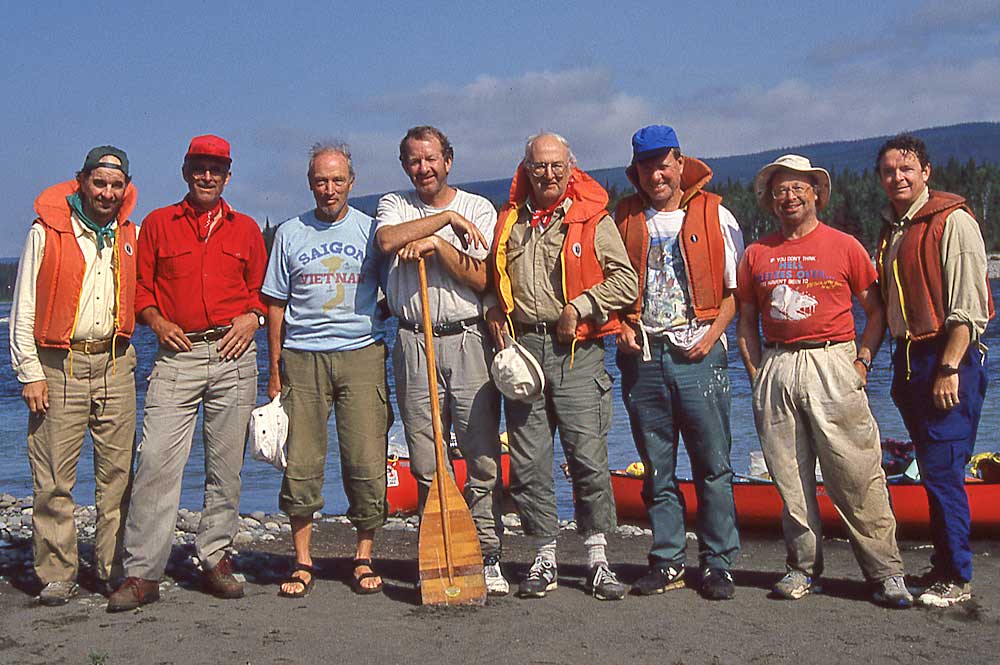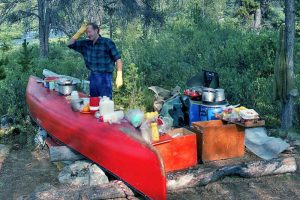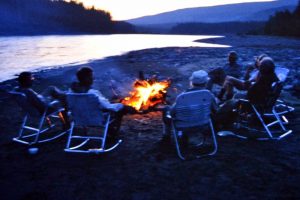A River “Down South” by John Gow
Craig called in early in ’94 to tell me that the wise men had met and chosen the Stikine as that year’s river, and adding, “Since you are in B.C., would you mind organizing access from Terrace to the river, canoes and flights?” No worries there, other than I was in Victoria, the southernmost point in British Columbia, and the Stikine was far to the north, I knew little about it, and had no contacts in the area.
I knew it was a great wilderness river that had survived repeated attempts over the years by BC Hydro to build a massive dam and hydro generation facility. It would have been nothing short of massive, irreparable destruction of precious and pristine wilderness. I also knew that the Stikine had its headwaters on the Spatsizi Plateau, a rolling alpine area, home to herds of caribou, numerous grizzly, alpine lakes and flora, yet also under siege, in this case from mining interests. Happily, BC Hydro had given up on the Stikine, and the Spatsizi had been made into a wilderness preserve, stalling the mines.
Stikine Country
The Stikine has three distinct characters over its five hundred plus kilometre length. The upper two hundred and twenty, that we would paddle, flows through a relatively wide “U” shaped mountain valley, dropping steadily from Happy, Tuaton and Laslui Lakes near its source to the crossing point of the Cassiar Highway. Below the highway, the river plunges into the Great Canyon of the Stikine, a stretch so violent that it has only been paddled by a handful of elite level kayakers. We would give that a miss.
Below the Great Canyon, the tiny town of Telegraph Creek marks the head of navigation on the Stikine, two hundred and ten kilometres from the Pacific. During the Yukon gold rush paddlewheel boats plied the river, braving fast water, rocks and log jams. Naturalist John Muir was one passenger, and compared the country of massive granite walls and some forty glaciers to “a hundred Yosemites”.
The Stikine was, even given its location in northern British Columbia, far south of the Arctic rivers the group usually paddled. Apparently though, it was time to paddle a mountain river, one of sufficient length and challenge, but without long and frequent portages. Pierre Trudeau, now retired from government, was to join us again, so some consideration was given to his advancing years. In fact, the whole group was getting older, and long portages had lost their charm.
An acquaintance at Dease Lake, a hundred kilometres further north, put me onto Tony Shaw, owner of Red Goat Lodge, a small inn located near the crossing of the Cassiar Highway over the Stikine. I was in luck, Tony was “Mr Canoe” for the region, had canoe rentals, and would make arrangements for our flight into Tuaton Lake at the head of the river. He would even pick up the group at the Terrace Airport and drive us the six hours north to his lodge.
Tony and his wife Doreen, longtime residents of northern BC, were the most hospitable and helpful people we could have hoped for. On Arrival we stayed at the Red Goat Lodge (named for mountain goats on the Spatsizi that roll in ochre pigmented clay). It was a great start to the trip.
The Stikine is moving water for its entire run from Laslui Lake to the takeout two hundred and twenty kilometres downstream. There is a lot of interesting paddling, but only a few portages, the first at Fountain Rapids just below Laslui. There, a large boulder in the middle of very fast water sends a plume of water vertically into the air, hence the name. A portage of one kilometre skirts that stretch.
While camped at Jewel Rapids we took a day off the water to hike up to a shoulder of Tomias Mountain, just north of the river. From our high point around 2,000 metres we had a fine view of parts of the alpine Spatsizi Plateau.
The most notable feature on the upper section is Beggarly Canyon, located about twenty kilometres above the take out. A kilometre long, narrow piece complete with a dog leg and boulders. Most of us paddled it, avoiding the fairly rough portage, recommended, though, in high water.
Just below Beggarly there is a huge and bizarre railway bridge spanning the river. Built by a resource mad provincial government in the 1960’s at a cost of some five million dollars, it was never used. The roadbed went in, but not a tie or rail appeared before the whole project was scrubbed!
We pretty well aced it on our Stikine trip. Water levels were just right and most importantly, the infamous mosquito population was dormant. We were treated to over two hundred kilometres of moving water through almost complete wilderness The Stikine it is a magnificent mountain river, we were fortunate to have paddled it in the company of good friends. John Gow – 1994
Stikine Groupies
The Stikine River Team – 1994

L-R: Tim Kotcheff, John Macfarlane, Pierre Trudeau, John Gow, Craig Oliver, Peter Stollery, Eddie Goldenberg, Ted Johnson.














